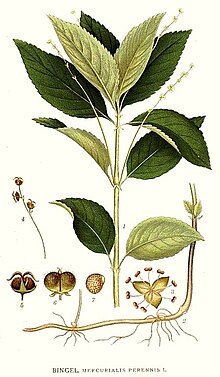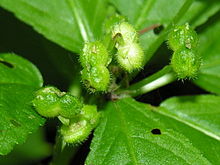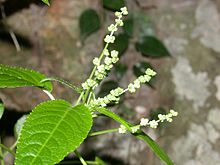Ringel herbs
| Ringel herbs | ||||||||||||
|---|---|---|---|---|---|---|---|---|---|---|---|---|

Annual ringelkraut ( Mercurialis annua ), male plant |
||||||||||||
| Systematics | ||||||||||||
|
||||||||||||
| Scientific name | ||||||||||||
| Mercurialis | ||||||||||||
| L. |
The mercurial herbs ( Mercurialis ) are a genus of plants within the milkweed family (Euphorbiaceae). The eight to ten species are common in Eurasia , with a focus on the Mediterranean .
description



Ringelkraut species are annual or perennial herbaceous plants , and more rarely woody plants that do not contain white milky sap. The opposite , often serrated leaves are broadly ovate to lanceolate-ovate, depending on the species.
Most species are dioecious separately sexed ( dioecious ), rarely are they single sexed separately ( monoecious ). The male flowers are clustered in axillary spikes , the female flowers are clustered in spikes or axillary clusters. Since the uppermost leaves are often a bit crowded, the ears usually protrude far beyond them, so that the impression of terminal ears is created. The flowers are inconspicuous green or yellowish green and have only a three or four-fold bloom circle . The male flowers usually have eight to 15 (rarely up to 20) stamens . In addition to the two- to three-part ovary, the female flowers only contain staminodes .
There are fruit capsules formed. The seeds have an aril .
Systematics and distribution
The genus Mercurialis was established by Carl von Linné in Species Plantarum in 1753 . Synonyms for Mercurialis L. are Cynocrambe Hill , Discoplis Raf. Synema Dulac . The scientific generic name Mercurialis is derived from the Roman god Mercurius , who, according to legend, discovered the healing powers of the plant.
The genus Mercurialis belongs to the subtribe Mercurialinae from the tribe Acalypheae in the subfamily Acalyphoideae within the family Euphorbiaceae .
Most of the species occur in the western Mediterranean region, two to three species in temperate Europe ( Mercurialis annua , Mercurialis perennis and Mercurialis ovata ), and one species ( Mercurialis leiocarpa Siebold & Zucc. ) Is common in South and East Asia.
species
The genus Mercurialis contains eight to ten species, depending on the author:
- Annual ringelkraut ( Mercurialis annua L. , Syn .: Synema annuum (L.) Dulac , Discoplis serrata Raf. , Mercurialis ambigua L. f. , Mercurialis ciliata C. Presl , Mercurialis ladanum Hartm. , Mercurialis monoica (Moris) BMDurand , Mercurialis pinnatifida Sennen , Mercurialis tarraconensis Sennen , Mercurialis annua subsp. ambigua (L. f.) Arcang. , Mercurialis annua var. ambigua (L. f.) Duby , Mercurialis annua var. angustifolia Gaudin , Mercurialis annua var. camberiensis Chabert , Mercurialis annua var. capillacea Guépin , Mercurialis annua var. dioica Moris , Mercurialis annua var. laciniata refuse. Arg. , Mercurialis annua var. monoica Moris , Mercurialis annua var. transsylvanica Schur , Mercurialis annua var. variegata Loehr ) It comes in Macaronesia , South and Central Europe and in the Mediterranean area to the Arabian Peninsula.
- Mercurialis canariensis Obbard & SAHarris : It occurs only in the Canary Islands.
- Mercurialis corsica Coss. & Kralik : It occurs in Corsica and Sardinia.
- Mercurialis elliptica Lam. : It occurs only on the southern Iberian Peninsula and in Morocco.
- Mercurialis huetii Hanry (Syn .: Mercurialis annua var. Huetii (Hanry) Müll.Arg. , Mercurialis annua subsp. Huetii (Hanry) Lange , Mercurialis ovata subsp. Huetii (Hanry) Nyman , Mercurialis annua f. Huetii (Hanry) Pax & K.Hoffm. ): It occurs only from southeastern France to northeastern Spain and in Morocco.
- Mercurialis leiocarpa sieve. & Zucc. (Syn .: Mercurialis transmorrisonensis Hayata , Mercurialis leiocarpa var. Transmorrisonensis (Hayata) H.Keng , Mercurialis leiocarpa var. Trichocarpa W.T.Wang ): It is in China, Bhutan, northeast India, Japan, Korea, Nepal and northern Thailand spread.
- Eiblättriges Bingelkraut ( Mercurialis ovata Sternb. & Hoppe , Syn .: Mercurialis perennis var. Ovata (Sternb. & Hoppe) Müll.Arg. , Mercurialis perennis subsp. Ovata (Sternb. & Hoppe) Celak. , Mercurialis ovata f. Genuina Pax & . K.Hoffm , Mercurialis livida . port Baumg ex. , Mercurialis ovata var. livida (port ex Baumg..) Nyman , Mercurialis ovata f. croatica sword ): you come into Central, Eastern and Southeastern Europe, in Turkey, in western Syria and in the Caucasus .
- Forest ringelkraut ( Mercurialis perennis L. , Syn .: Mercurialis perennis f. Genuina Müll.Arg. Nom. Inval., Synema perenne (L.) Dulac , Mercurialis cynocrambe Scop. , Mercurialis nemoralis Salisb. , Mercurialis sylvatica Hoppe , Mercurialis longifolia host nom. illeg., Mercurialis perennis var. brachyphylla Willk. , Mercurialis alpina Schur , Mercurialis perennis var. Subalpina Schur , Mercurialis perennis subvar. alpina (Schur) Nyman , Mercurialis perennis subvar. sylvatica (Hoppe) Nyman , Mercurialis perennis f. saxicola Beck , Mercurialis perennis f. Glabra Beck , Mercurialis sylvestris Bubani , Mercurialis perennis f. Robusta Gross , Mercurialis perennis f. Sylvatica (Hoppe) Rouy & Foucaud , Mercurialis perennis f. Ovatifolia Hausskn. ) It is found in Central Europe and in the Mediterranean as far as the northern Iran.
- Mercurialis reverchonii Rouy (Syn .: Mercurialis annua var. Serratifolia ball , mercurial serratifolia (Ball) Pau , mercurial reverchonii . Var riatarum Maire , mercurial reverchonii var. Serratifolia (Ball) Maire ): It occurs only in southwestern Spain and Morocco.
- Mercurialis tomentosa L. (Syn .: Mercurialis sericea Salisb. ): It is native to south-western Europe.
Then there are the hybrids:
- Mercurialis × longifolia Lam. = Mercurialis annua × Mercurialis tomentosa
- Mercurialis × paxii Graebn. = Mercurialis ovata × Mercurialis perennis .
Origin of names and other common names
The German trivial name "Bingelkraut" probably comes from Bunge = tuber or Bingel = testicle , and refers to the spiky, hairy fruits that are often in pairs. It is also found under the common names Schuttbingel, Wintergrün, Hundkohl and Büngelkraut.
Healing effect
Bingel herbs are hardly used as medicinal plants today. Their laxative effect has been proven.
Toxicity
A slight toxicity is ascribed only to the forest ringelkraut. The highest active ingredient content is reached when the fruit is ripe. Poisoning in humans is hardly possible. Due to the fact that animals ingest larger amounts with food, horses, pigs or ruminants react more sensitively.
swell
literature
- Huaxing Qiu, Michael G. Gilbert: Mercurialis. In: Wu Zheng-yi, Peter H. Raven, Deyuan Hong (Eds.): Flora of China . Volume 11: Oxalidaceae through Aceraceae . Science Press / Missouri Botanical Garden Press, Beijing / St. Louis 2008, ISBN 978-1-930723-73-3 , pp. 247 (English, online ). (Sections Description and Distribution)
- Rudolf Schubert , Klaus Werner, Hermann Meusel (eds.): Excursion flora for the areas of the GDR and the FRG . Founded by Werner Rothmaler. 14th edition. tape 2 : vascular plants . People and knowledge, Berlin 1988, ISBN 3-06-012539-2 .
- Urania plant kingdom . Volume 3: Flowering Plants 1 , 1st edition. Urania, Leipzig 1991, ISBN 3-332-00367-4 .
- Henning Haeupler, Thomas Muer: picture atlas of the fern and flowering plants of Germany . Ed .: Federal Agency for Nature Conservation (= The fern and flowering plants of Germany . Volume 2 ). Eugen Ulmer, Stuttgart (Hohenheim) 2000, ISBN 3-8001-3364-4 .
- Hayashi Yasaka: Nihon-no Yasou. Yama to Keikoku Sha. Tokyo 1983, ISBN 4-635-09016-7 .
Individual evidence
- ↑ Carl von Linné: Species Plantarum. Volume 2, Lars Salvius, Stockholm 1753, p. 1035 ( digitized ).
- ↑ a b World Checklist of Selected Plant Families, 2010, The Board of Trustees of the Royal Botanic Gardens, Kew, incorporated into Euro + Med .
- ↑ a b c Rafaël Govaerts (Ed.): Marcurialis. In: World Checklist of Selected Plant Families (WCSP) - The Board of Trustees of the Royal Botanic Gardens, Kew . Retrieved July 30, 2014.
- ^ Mercurialis in the Germplasm Resources Information Network (GRIN), USDA , ARS , National Genetic Resources Program. National Germplasm Resources Laboratory, Beltsville, Maryland. Retrieved August 16, 2013.
- ↑ a b Lutz Roth, Max Daunderer, Kurt Kormann: Toxic Plants - Plant Poisons. Occurrence, effect, therapy, allergic and phototoxic reactions. With a special section about poisonous animals. 5th expanded edition. Nikol, Hamburg 2008, ISBN 978-3-86820-009-6 . Pp. 495-496.
- ↑ Mannfried Pahlow: The great book of medicinal plants. Gräfe & Unzer, Munich 1979, ISBN 3-7742-4211-9 .
Web links
- Description in the Western Australian Flora . (engl.)
- Euphorbiaceae in Spain. (PDF file; 1.81 MB)
- Entries about Mercurialis in Plants For A Future


